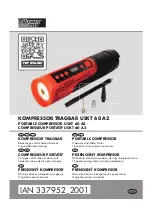
R90 - 160N / R90 - 160I / R90 - 160NE / R90 - 160IE
http://www.ingersollrandproducts.com
6
8.0 GENERAL INFORMATION
8.4 GENERAL DESCRIPTION
The compressor is an electric motor driven, contact
cooled screw compressor, complete with all necessary
components piped, wired and baseplate mounted. It is a
totally self contained air compressor package.
The standard compressor is designed to operate in an
ambient range of 1.7° C to 46° C (35° F to 115° F). The
standard maximum temperature of 46° C (115° F) is
applicable up to an elevation of 1000m (3280ft) above
sea level. Above this altitude significant reductions in
ambient temperature are required if a standard motor is
to be used.
The compressor is managed by the onboard electronic
controller. The controller and drive system operate
together to vary the speed of the compressor to deliver
compressed air at the target pressure.
For FS the capacity is automatically controlled via ‘ON-
OFF LINE’. The compressor will operate to maintain a set
discharge line pressure and is provided with an auto
restart system for use in plants where air demand varies
widely.
Panel instrumentation is provided to indicate the
compressor operating conditions and general status.
The air/coolant mixture discharges from the compressor
into the separation system. This system removes all
but a few PPM of the coolant from the discharge air.
The coolant is returned to the cooling system and the
air passes to the aftercooler and out of the compressor
through the moisture separator.
Air is pulled into the machine by the cooling blower and
through the coolant cooler and aftercooler.
By cooling the discharge air, much of the water vapor
naturally contained in the air is condensed and is drained
from the built-in moisture separator and drain.
The coolant system consists of a sump, cooler,
thermostatic valve and a filter. When the unit is operating,
coolant is forced by air pressure from the separator tank
to the thermostatic element. The position of the element
(a direct result of coolant temperature) will determine
whether the coolant circulates through the cooler,
bypasses the cooler, or mixes the two paths together to
maintain an optimum compressor injection temperature.
This temperature is controlled to preclude the possibility
of water vapor condensing. By injecting coolant at a
sufficiently high temperature, the discharge air coolant
mixture temperature will be kept above the dew point.
For VSD the system is enhanced by a control logic that
varies the cooling blower speed dependant on the intake
and discharge temperatures and hence controls the
injection temperature even closer while saving blower
motor energy.
The compressor is provided with a temperature sensor
which will shut the unit down in case of excessive
temperature, 109° C (228° F).
Effective coolant filtration is provided by the use of a
screw on, heavy duty coolant filter.
NOTICE
Standard air compressors are factory filled with SSR Ultra Coolant. It is recommended to perform a coolant
analysis every 2000 hours or 3 months to monitor condition and determine when to change the coolant. If
an analysis is not performed, the recommended coolant change interval is 8000 hours or 2 years, whichever
comes first.
For units supplied with optional Food Grade Coolant, is recommended to perform a coolant analysis every
500 hours or every month to monitor condition and determine when to change the coolant. If an analysis
is not performed, the recommended coolant change intervals is 2000 hours or 6 months, when utilizing the
X-Tend Food Grade filter supplied with the machine. For units running Food Grade Coolant WITHOUT the X-
Tend Food Grade Filter, the change interval should be 1000 hours or 6 months, whichever comes first.
The coolant must be changed at these intervals to avoid breakdown and equipment damage.
NOTICE
FS (Fixed Speed) compressor should not be connected to a VSD. Please contact your local Ingersoll Rand
representative before inverter duty conversion.
CAUTION
LOW DEMAND APPLICATIONS
For FS during periods of low demand, the compressor may not reach its normal operating temperature.
Sustained operation at low demand can result in the build up of condensate in the coolant. If this situation
occurs, the lubricating characteristics of the coolant can be impaired which may lead to damage of the
compressor.
THE COMPRESSOR SHOULD BE ALLOWED AMPLE LOADED RUNNING TIME.
















































